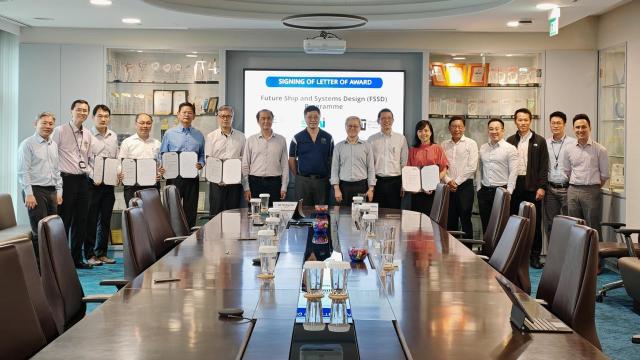
Professor Tan Thiam Soon, President, SIT and Professor Tan Chorh Chuan, President, NUS sign the Collaborative Agreement that will see NUS jointly deliver courses for SIT’s Allied Health degree programmes. The signing was witnessed by Dr Janil Puthucheary, Minister of State, Ministry of Communications and Information & Ministry of Education. Also present at the signing were (from left to right) Mr Chan Wing Leong, Deputy President (Administration) & Chief Financial Officer, SIT, Professor Loh Han Tong, Deputy President (Academic) & Provost, SIT, Professor John Eu-Li Wong, Senior Vice President (Health Affairs), NUS, Associate Professor Yeoh Khay Guan, Dean, NUS Medicine
The Singapore Institute of Technology (SIT) inked its first Collaborative Agreement with the National University of Singapore (NUS), to jointly deliver courses for SIT’s Allied Health degree programmes, namely the Bachelor of Science degrees in Physiotherapy, Occupational Therapy, Diagnostic Radiography and Radiation Therapy.
The collaboration entails the co-development and co-teaching of curricula, pedagogical research and access to NUS lab facilities for SIT students. Lectures and tutorials will be held in SIT’s interim campus at Dover, and lab sessions will be conducted at nearby NUS. SIT’s faculty will co-teach Anatomy and Physiology (A & P) modules with faculty from the NUS’ Yong Loo Lin School of Medicine.
Under the five-year Collaboration Agreement, NUS will be responsible for the teaching of topics such as musculoskeletal, renal and endocrine system, which form part of the modules. Both SIT and NUS will jointly plan and prepare the course materials for these topics.
Speaking at the signing ceremony, Professor Tan Thiam Soon, President of SIT, acknowledged the contributions of Associate Professor Yeoh Khay Guan, Dean of NUS’ Yong Loo Lin School of Medicine, who had been instrumental to this partnership. He said, “This collaboration will ensure that the Anatomy & Physiology components in these Allied Health degree programmes are not only relevant, rigorous and future-ready, but are also well-integrated with the respective Allied Health curricula.
“Furthermore, SIT students will be able to strengthen their applied knowledge, gain mastery of key subjects in their degree programmes, and become better specialists in areas such as physiotherapy, occupational therapy, diagnostic radiography and radiation therapy. It is no secret that there is a growing demand for well-trained allied health professionals to meet the healthcare needs of Singapore’s ageing population,” added Prof Tan.
NUS President Professor Tan Chorh Chuan said, “NUS is delighted to collaborate with SIT on this important initiative because our joint work will translate into more, well-trained and qualified professionals for our national healthcare system. The need for this is high and growing, particularly with Singapore’s rapidly ageing population. NUS’ Yong Loo Lin School of Medicine has world-class expertise and state-of-the-art facilities for biomedical and health sciences education. By partnering with SIT, we can make these available to an expanded student population and contribute in new ways to training healthcare professionals for Singapore.” NUS will welcome the first batch of SIT students to its Kent Ridge campus next month.
Professor Alan Wong, SIT’s Cluster Director, Health & Social Sciences said, “While SIT is building its capability in A & P, as well as planning for the teaching and learning facilities in these disciplines, there is still much for SIT to learn from NUS in A & P education. The faculty from both universities are keen to collaborate in pedagogical research in A & P education for these health sciences programmes.”

Dr Janil Puthucheary, Minister of State, Ministry of Communications and Information & Ministry of Education and heads of SIT & NUS take a tour of the Anatomy Museum housed at NUS Human Anatomy Teaching facility. The collaboration will allow SIT’s Allied Health students to benefit from lab sessions at NUS Human Anatomy Teaching facility, where they would get to learn anatomy and physiology subjects in an applied manner integrated with clinical case studies.
About Singapore Institute of Technology
Singapore Institute of Technology (SIT) is Singapore’s new autonomous university of applied learning. It aims to be a leader in innovative university education by integrating learning, industry and community as part of its unique pedagogy. Partnering world-class universities, SIT offers applied degree programmes targeted at growth sectors of the economy. SIT also aims to cultivate in its students four distinctive traits, or the SIT-DNA, which will prepare them to be ‘thinking tinkerers’, who are ‘able to learn, unlearn and relearn’, be ‘catalysts for transformation’ and finally, become ‘grounded in the community’.
About National University of Singapore (NUS)
A leading global university centred in Asia, the National University of Singapore (NUS) is Singapore’s flagship university, which offers a global approach to education and research, with a focus on Asian perspectives and expertise.
NUS has 17 faculties and schools across three campuses. Its transformative education includes a broad-based curriculum underscored by multi-disciplinary courses and cross-faculty enrichment. Over 38,000 students from 100 countries enrich the community with their diverse social and cultural perspectives.
NUS has three Research Centres of Excellence (RCE) and 27 university-level research institutes and centres. It is also a partner in Singapore’s fifth RCE. NUS shares a close affiliation with 16 national-level research institutes and centres. Research activities are strategic and robust, and NUS is well-known for its research strengths in engineering, life sciences and biomedicine, social sciences and natural sciences. It also strives to create a supportive and innovative environment to promote creative enterprise within its community.
For more information on NUS, please visit www.nus.edu.sg.
![[FA] SIT One SITizen Alumni Initiative_Web banner_1244px x 688px.jpg](/sites/default/files/2024-12/%5BFA%5D%20%20SIT%20One%20SITizen%20Alumni%20Initiative_Web%20banner_1244px%20x%20688px.jpg)


